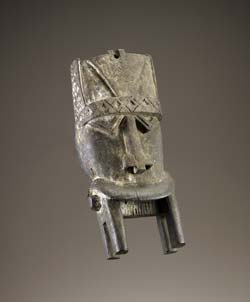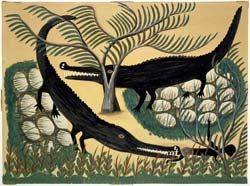
The hippopotamus is a water animal that travels on
land and embodies wealth and danger. Hippos provide wealth in terms of ivory and meat. They are very
aggressive and can be dangerous to humans--whether in a
boat or on land--caught between the hippo and the water.
While its wallows are destructive to shore and shallows, the
hippo's actions do not stir up quite the same negative emo-
tions as the crop destruction of other animals.
Crocodiles also pose a threat on and by the water.
Surprisingly, although the actual beast is a danger, its roles
in art and oral literature are positive. Among the Dogon
peoples the crocodile is described as a protector of scarce
pools of water and a servant of the nommo, the mythic
beings involved in the creation of mankind and culture.
Crocodile masks are part of a complex ritual cycle of masks
in initiations, funerals and, after the mid-20th century,
entertainment performances.
The crocodiles in the painting by Kaballa, a member
of a central African modernist art movement, appear to be
guarding or nurturing their eggs (acc. no. 2002-11-4). A
wealthy person would have owned the large Akan crocodile
weight (acc. no. 75-3-490), and the "crossed crocodiles have
one belly but when eating they fight" weight (acc. no. 75-3-
290) conveys the meaning that, as in any family, there is
unity in diversity. It can also be a mockery of greediness
because in the end all goes to the same place.

Hippo waterspirit mask
Ijo peoples, Nigeria
Early 20th century
Wood, pigment
Museum purchase, 2006-2-1
|

Kaballa
b. 1920, Lubumbashi, Democratic Republic
of the Congo
Untitled
c. 1940s–1950s
Oil on paper
Anonymous gift, 2002-11-4
|
|
|
|